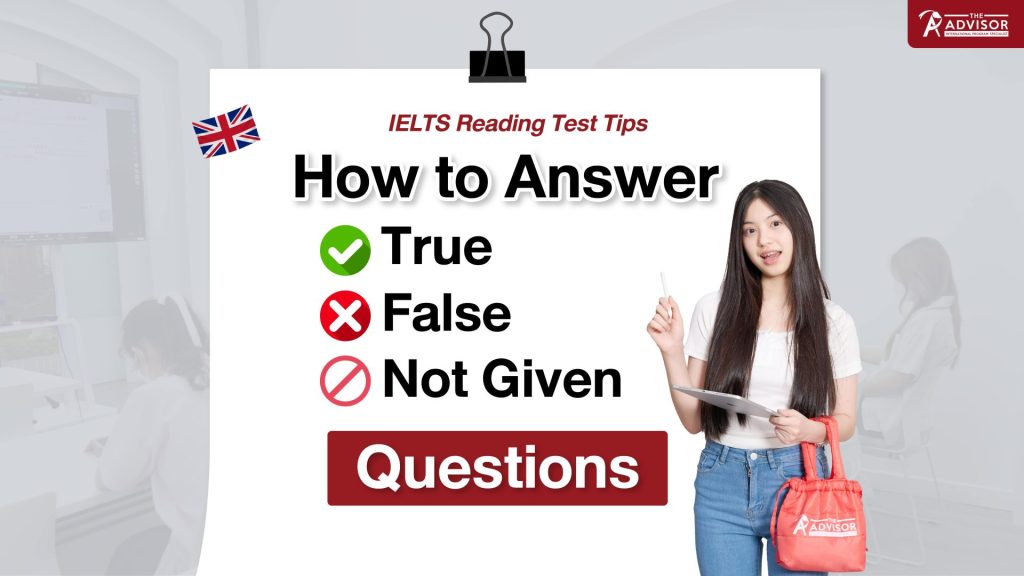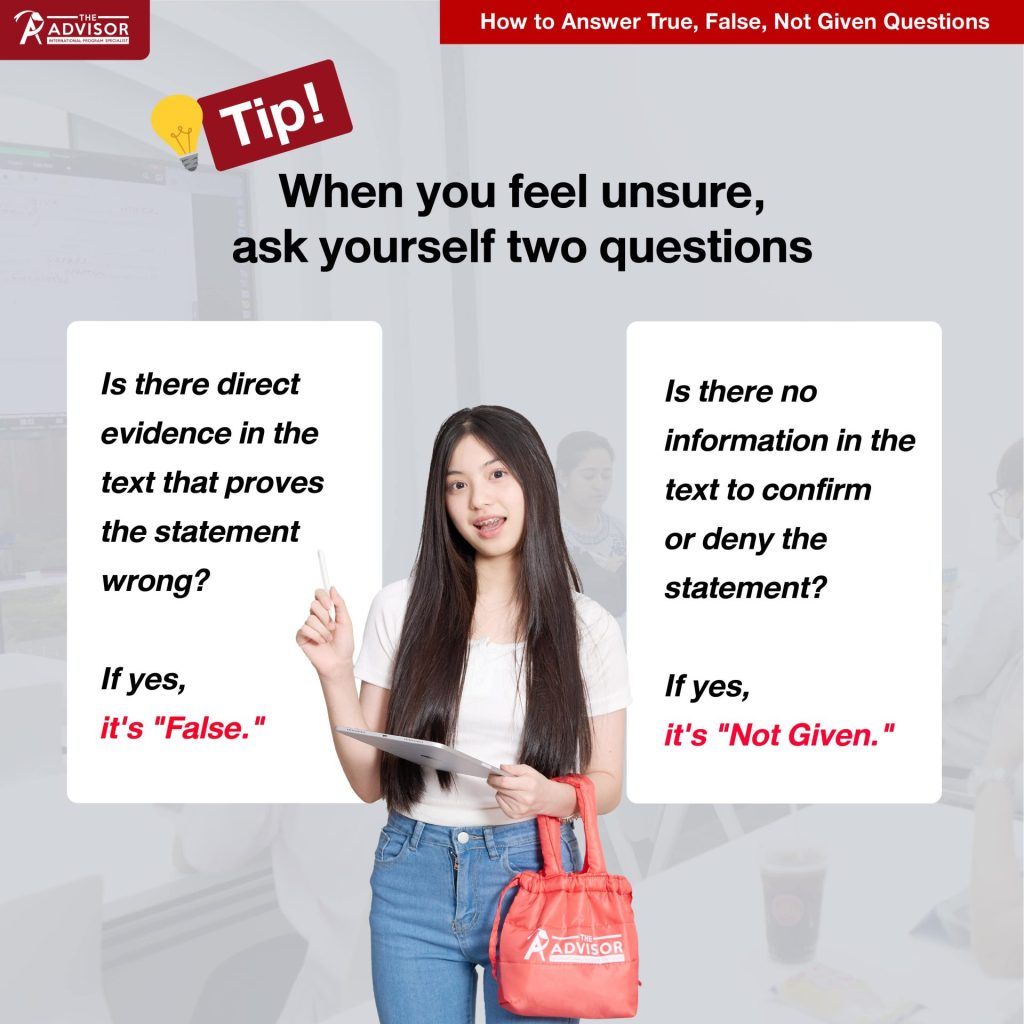IELTS Reading Test Tips: How to Answer True, False, Not Given Questions

The True, False, Not Given (TFNG) questions are often considered one of the most challenging parts of the IELTS Reading test. Many test-takers struggle with these questions because they require careful and precise reading. The test requires you to analyze text and distinguish between subtle nuances of meaning. This guide will walk you through effective strategies to tackle TFNG questions and improve your score.
IELTS Reading: True, False, Not Given Explained
Before diving into strategies, you should understand what the True, False, Not Given questions are.
- True: The statement exactly matches information in the text. Every detail of the statement is directly supported by the passage’s content.
- False: The statement contradicts information in the text. This means the passage explicitly states something different from the given statement.
- Not Given: The information is simply not present in the text, or there’s insufficient information to make a definitive judgment.
For a clearer understanding, here is a sample of passage and questions with answers:
Passage: Marine Conservation Efforts
Ocean conservation has become increasingly important in recent decades. Scientists have discovered that coral reefs are critically endangered ecosystems, with approximately 50% of the world’s coral reefs having disappeared in the last 30 years. Climate change, ocean acidification, and human activities like overfishing and pollution are the primary threats to marine biodiversity. Researchers are developing innovative strategies to protect and restore marine habitats, including artificial reef construction and marine protected areas.
Questions:
- Coral reefs have completely disappeared from the world’s oceans.
- Human activities negatively impact the marine ecosystems.
- Scientists have found a solution to protect coral reefs.
Answers:
- False: The passage states that “approximately 50% of the world’s coral reefs having disappeared”, not “completely disappeared.”
- True: The passage mentions that “human activities like overfishing and pollution are the primary threats to marine biodiversity.”
- Not Given: The passage lacks sufficient information to confirm or deny the scope and success of research efforts aimed at protecting coral reefs.
IELTS True, False, Not Given strategies
Here are some practical strategies for improving your IELTS True, False, Not Given score.
- Read the statements carefully
You must pay extremely close attention to the exact wording of each statement and recognize that subtle nuances can drastically change the meaning. You should look for keywords and specific details that help you match the statement to the text. Beware of qualifiers like “all,” “always,” “never,” “most,” and “some,” which can change the meaning. Here is a sample question.
Passage: Renewable energy sources have grown dramatically in recent years. Solar power installations increased by 22% annually in European countries between 2015 and 2020.
Question: Between 2015 and 2020, most European countries have increased their solar power installations by 22%.
Answer: Not Given
Reason: The passage only discusses “European countries” without “most,” and there is no information to indicate how many European countries are included in the survey.
- Locate relevant sections in the passage
Efficient text navigation is strategically important for the IELTS reading, especially for effective time management. With skimming and scanning techniques, you should be able to quickly scan the passage and identify sections that appear related to the statement in question.
- Identify keywords and locate the relevant sections.
- Don’t rely on your memory; always refer back to the original text.
- Use keywords from the passage to guide your search.
- Be precise in your interpretation
You must look for exact matches, not just similar ideas. Statements that seem similar or close to the passage might still be false. Even small differences in wording can completely change the meaning of a statement. This requires a careful, almost forensic approach to text analysis, where every word and phrase is scrutinized.
- Don’t apply outside knowledge or personal experience to “Not Given”
Often, test-takers find the “Not Given” answer to be the most challenging and confusing. Here’s a practical tip: classify a statement as “Not Given” if you can’t find clear evidence to mark it as true or false. You must resist the urge to guess or make assumptions. Don’t apply your previous knowledge or personal experience to the test. Stay focused on what is actually in the text.
Common Traps in True, False, Not Given Questions
The IELTS True, False, Not Given question is like a tricky linguistic mind game. The test is deliberately designed to use paraphrasing and complex language structures to make you second-guess your responses. Another challenge is to find the exact textual meaning while avoiding assumptions or personal interpretations. Here are some mistakes to avoid in the True, False, Not Given section.
- Confusing inference with explicit statements
One of the most frequent mistakes test-takers make is misinterpreting the difference between explicit and inferred text. For example:
Passage: Researchers estimate that vertical farming can yield up to 350 times more produce per square meter compared to conventional agricultural methods.
Question: Vertical farming produces 350 times more per square meter than traditional farming.
Answer: Not Given
Reason: The passage states that “Researchers estimate that vertical farming can yield up to 350 times,” which is an inferred statement, not an explicit one.
- Misunderstanding “Not Given” vs. “False”
Another critical error is confusing “Not Given” with “False.” Many test-takers struggle to distinguish between these two options:
- False: The statement contradicts the information in the text.
- Not Given: The statement does not confirm or contradict the information.
Students often hastily mark a statement as “False” when they can’t find supporting evidence, when in fact, it should be “Not Given.” This mistake can lead to unnecessary point deductions.
Tip: When you feel unsure, ask yourself two questions
- Is there direct evidence in the text that proves the statement wrong? If yes, it’s “False.”
- Is there no information in the text to confirm or deny the statement? If yes, it’s “Not Given.”

- Getting trapped by paraphrasing and synonyms
Paraphrased language and synonyms are keys to the IELTS True, False, Not Given section. Test-takers often make the mistake of looking for exact word matches, which can lead to incorrect answers. For example, if the passage says “young individuals” and the statement mentions “teenagers,” these could be referring to the same group. You need to understand the underlying meaning, not just look for identical words.
Conclusion
Achieving a higher score for the IELTS True, False, Not Given section requires consistent practice, careful text analysis, and a strategic approach. You must develop active reading skills to distinguish statements that are explicitly supported, contradicted, or neither confirmed nor refuted in the text. Remember: Precision, careful reading, and a strategic approach are your keys to success!